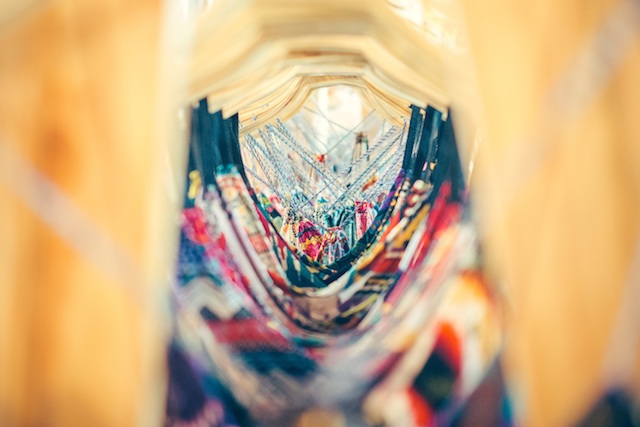
Last week, in an attempt to break up my walk home during a sub-zero evening, I stood in the heated sanctuary of an Urban Outfitters fingering the hem of the cutest onesie I had ever seen.
And not just any onesie. It was made of a sort of fleecey material printed with cute little stars and soft looking snowflakes, and despite having long sleeves, it was cut into booty shorts and buttoned up the middle from the crotch to somewhere mid-cleavage.
I imagined myself wearing it, sitting in front of a Pinterest-worthy fireplace with a tiny dog in my lap and my Abercrombie-centrefold-looking boyfriend bringing me a mug of cocoa and smiling at how goddamn cute I looked.
Since I’ve never owned a dog and I definitely don’t have a boyfriend, the image in my head can only have been inspired by a combination of scenes that have played out on Instagram, Pinterest and Facebook over the past years of my life—rotating style, cut and make of said outfit.
When we see these pictures, these Vogue editorials, these storeys-high ads in Times Square or your local metro station, it’s easy to forget that what we’re viewing is a highly-curated snapshot of an ideal; a feeling encapsulated in a single moment frozen in time. A moment that is staged and very much outside of what your or my day-to-day reality looks like.
We do not see the garment being worn in various climates, being cleaned, fading in the wash. We don’t see the girl in the heels attempting to walk to the bar, we don’t see the factory worker in Bangladesh stitching the seams together, nor the chemicals dumped into the water supply during production.
In a world that’s progressing at breakneck speed, jumping from one fad to the next almost faster than it takes to create it, fast fashion dominates the market and our buying trends. And it doesn’t have time to consider the more practical matters that exist when it comes to dressing ourselves.
As a society, we’ve created a non-renewable, impossible to recycle, steam-rolling industry of garbage clothing.
Garbage clothing.
And we’re throwing out this clothing at such a rate that “84 percent of unwanted clothes in the United States in 2012 went into either a landfill or an incinerator.”
We live in a time where it’s normal and understood, even expected, that the clothing we buy isn’t going to last us. Maybe we already know that we’re buying garbage but we turn a blind eye because we have a neon-themed party coming up or we think our niece would look just adorable in the kitten-eared headband that caught our eye in the window at Baby Gap.
We don’t think about the “cost per wear” (CPW), we instead think about the piece itself and the cost to us in the moment we see it. There’s an implicit understanding that owning it now for such-and-such event, or to look like a Kardashian, is more important than how often we wear it.
Firstly, because trends are marketed to us as needing to be worn immediately; but also because it’s frowned upon to be seen in the same outfit twice—it’s even an accepted female-centric expectation that conditions our daily clothing choices.
Recycling outfits doesn’t align with how we’re supposed to appear in a world where the power of social media blinds us to the karmic implications our choices have on the planet.
Like with any issue of environmentalism or mindfulness, the solution is not easy.
It’s hard to resist reckless indulgence when there are gorgeous suede mini dresses at Forever 21 that are literally so cheap it makes you forget about the eight-year-old Filipino kid who sewed the damn thing by hand.
It’s even harder when you’re not aware in the first place that an eight-year-old was the one who made it, in absolutely deplorable conditions.
We have high standards for ourselves, why not for the clothing we wear?
When we know that every penny we spend is a vote toward what we want our future to look like, it’s somewhat easier to turn to thrift stores, local slow fashion designers and clothing swaps with our friends and community.
Here are my top five ways to avoid purchasing fast fashion:
1. Dress classically/timelessly
Dressing classically/timelessly means you choose styles, cuts, prints, and accessories that are not fad driven, can be worn over many seasons and are made well enough that they last years of wear.
Bonus points: Look to slow fashion brands when purchasing your next classic piece.
2. Thrift
Research the three to five thrift stores closest to you and start frequenting them. In my experience it takes semi-regular, hour-long trips to really sift through the contents of these places to find the gems.
However, this doesn’t give you carte-blanche to purchase frivolously just because you find something awesome. Always consider whether or not it already fits into your wardrobe, or if you’re buying it just because it’s a great score. There’s enough to go around!
Bonus points: Only shop at thrift stores that support not-for-profit organizations, meaning that the profit they make from your purchases go to back into good causes, such as the Salvation Army.
3. Swap with your friends/community
Organizing a swap between your friends on a seasonal basis is a great way to re-vamp your wardrobe, save money and, let’s face it, have an excuse to drink wine and get together.
Community-wide swaps are happening already on Facebook (search for “clothing swap + your city name” and look at the groups that come up) and most likely in your city.
4. Repair
Favourite jeans ripped? Repair them instead of throwing them out. Same goes for holes in sleeves, undone hems, and de-soled shoes. Think about long-term CPW instead of buying a new pair every couple months.
Don’t know where to look? Often your local dry-cleaner will offer tailoring and repair services, or will be able to recommend you something close by. Stop in a high-end shoe store and ask for their suggestions on great shoe repair services in the area.
5. Educate yourself
The more you know about the clothing you wear (three out of four pieces of clothing made this year will end up in the landfill), the food you eat (we waste 40 percent of the food we buy every year!), your daily impact on the environment (the ocean is full of un-recyclable plastic that’s killing marine life!), the less you’ll want to buy of anything let alone fast fashion. The future is in sharing and really enjoying the resources we already have, not in creating more.
It takes a little foresight and consciousness, but, as you’ll find with all the best things in life, they all do.
~
Author: Chloe Cotter
Images: Unsplash/Igor Ovsyannykov
Editor: Erin Lawson

 Share on bsky
Share on bsky






Read 0 comments and reply